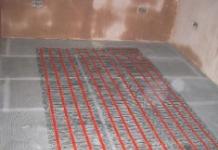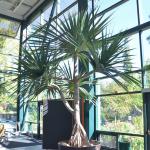Supplying power to a circuit of LEDs is no different from any other similar circuit of several DC consumers, which are powered by a rectifier from a household variable network. This article will consider both ready-made switching power supplies (UPS) and schematic diagrams of several home-made blocks for.
More often than others, sets of LEDs with a voltage of 12 volts are used. This is due to the short length of the purchased tapes and the prevalence of devices that produce this voltage. A large length - from about 5 meters, will require more voltage passing through thin copper conductors connecting the diodes.
Device types
Depending on the type of room where the backlight will be used, the type of power supply is selected. Purely visually, they can be divided into perforated metal, similar to a laptop power supply, and metal embossed without visible holes.
Functionally, these current sources can be equipped with dimmers or a control panel. In hardware stores, UPSs can be found under the names “switching current rectifier” or “LED lighting driver”. Each model of a switching power supply has its own level of protection against external influences.
The protection level code is located in the documentation or engraved on the case. It consists of the abbreviation IP and a couple of numbers. The first digit indicates the degree of protection against solid foreign objects - impact resistance, and the second is the moisture protection class.
Selecting a power supply
There are three main criteria for selecting a suitable UPS for tapes - the tightness of the unit, the peak power of the consumer and the output voltage.
Among the UPS for LED strips, the following protection classes are most common:

Peak output power is calculated based on total power all LEDs in the strip at their maximum brightness. Sometimes the manufacturer specifies how much power should be used per meter of tape. But if there is no such characteristic, you can find out the power of one meter by multiplying the maximum power of one LED by their number.
20% of the margin is usually added to the value obtained. The approximate power of one meter of LED 12-volt LED backlight is 60 watts. In order to provide a degree of illumination equal to a conventional incandescent base lamp, you need to use a 10-watt tape.
Additionally, you should take care of cooling the power supply by choosing a well-ventilated place away from radiators and other heat sources. A switching power supply with a metal case, in addition to cooling grids, can be equipped with an active cooling system fan. The operating range of the UPS ranges from -25 to +40 degrees for devices with an average and low protection class.
 A switching power supply with a metal case, in addition to cooling grids, can be equipped with an active cooling system fan
A switching power supply with a metal case, in addition to cooling grids, can be equipped with an active cooling system fan Cost Overview
Simple unprotected models with passive cooling for the spring of 2017 have an estimated cost of 10-20 rubles per 1 W of power. More expensive models with a sealed case and a cooling system have a cost in the range of 40 rubles per 1 watt.
Price for 12 V power supplies for LED strips start at 100 rubles for models with a power of 18-20 W on Aliexpress and similar Internet sites. In retail stores, the markup can reach up to 50-80 rubles per 1 W for the most primitive UPSs.
It is also worth considering the fact that the manufacturer often significantly overestimates the characteristics of its device. The easiest way to distinguish a powerful device visually is to have large cooling radiators and large wires.
 More expensive models with a sealed case and a cooling system have a cost in the range of 40 rubles per 1 W
More expensive models with a sealed case and a cooling system have a cost in the range of 40 rubles per 1 W Do it yourself
Of course, it is possible to independently manufacture this current source based on amateur radio circuits. To begin with, you should understand a little about the principle of operation and the design elements of power supplies from a 220 V household network.
It is strongly not recommended to use an archaic transformer power supply directly due to strong heating and incompatibility of current-voltage characteristics (CVC) of LED technology. The CVC of lighting LEDs is not directly proportional, the current consumption here does not grow in a straight line, but exponentially.
When connecting the tape to suitable power supplies from a laptop or tablet, you should use additional voltage regulators that lower it from 19 Volts to 12 based on the LM2596 block. Such a device has a high efficiency, reaching 90% and a low cost - up to 50 rubles per piece with delivery in the online store.
Find it in the catalog by simply typing in the name. The lack of power can be compensated by cutting a long tape into several equal parts and making several such blocks, after which they are connected in parallel and connected to the network. LM2596 can be used to power the tape from a car's cigarette lighter by connecting it through a 5A fuse.
To manufacture a switching power supply completely from scratch, it will first be necessary to assemble a simple 220-volt AC rectifier, and then build up the design with several cascades of pulse rectifiers and a pulse-width modulation module, if desired, providing an additional cooling system. The bulk of the parts can be obtained in outdated uninterruptible power supplies and computer power supplies.
The first version of the 12 V current source for the tape is a modified PSU from a computer based on the IR2151 half-bridge driver. The block is small-sized and can be placed in the case from the computer block itself with minimal alterations.
 Diagram of a transformerless power supply with a ballast capacitor
Diagram of a transformerless power supply with a ballast capacitor The transformer will need to be opened and rewound. The primary winding is wound with copper wire with a diameter of 0.8 mm and consists of 40 turns. The secondary needs 2x3 turns of a bundle of 7 strands of wire of the same diameter. Behind the secondary winding is a coupled 2x30 Amp Schottky diode, screwed to the case for cooling.
Almost all capacitors of the required capacities can be found on the computer power supply board. Manipulations with an increase or decrease in their capacity directly affect the power of the power supply.
To power the main microcircuit, you need a very powerful limiting resistor rated at 2 W, its heating during operation contributes to fluctuations in the nominal resistance by one tenth of the total value, but this will not affect the brightness of the lighting.
Field-effect transistors are protected from voltage surges by an additional thermistor. The diode bridge is built of 4 1N5408 diodes, designed for a voltage of 1 kV and a current of 3A. This PSU is extremely powerful and is designed for a large load of several hundred watts.
The design flaw is the lack of a dimmer to regulate the brightness of the glow and the built-in fan of the cooling system, which must be connected to a separate power supply to avoid flickering of the tape.
The resulting UPS can and should be equipped with additional functionality. Due to the low voltage used, the classic dimmer, which works on the principle of changing the output voltage, is not suitable for the design. Instead, a dimmer circuit will be considered for smoothly adjusting the brightness (for monochrome) and color (color) tapes based on PWM.
On sale there is a ready-made regulator board with high current and low voltage NM4511 worth 300 rubles from the specialized company MasterKit. However, self-assembly will not be difficult and skillful. The circuit is based on a dual operational amplifier LM358 and a powerful transistor IRF3205.
 Finally, I would like to talk about the cooling of the assembled structure, which will pass a high amperage current. As mentioned above, to eliminate the flickering effect, the fan should be powered from a separate power source.
Finally, I would like to talk about the cooling of the assembled structure, which will pass a high amperage current. As mentioned above, to eliminate the flickering effect, the fan should be powered from a separate power source.
In the considered scheme, it is possible to connect it in parallel with the main line of the primary circuit of the power supply. It is better to supply the transformer itself with a separate radiator, pressing it to the core with thermal paste and fixing it with bolts on the main board.
To increase the heat exchange area, you can replace one of the housing covers with a large radiator, which can be found in old Soviet amplifiers and voltage rectifiers. A good solution would be to use computer PSU models that use a large diameter fan, as they produce less noise.
Good afternoon, dear readers! Today we will assemble a simple power supply for low-power loads. I’ll make a reservation right away that the power of the circuit can be increased, but more on that later.
This is what the assembled structure looks like:
Pretty compact.
Main characteristics:
- Output voltage - 12 Volts;
- Power - 5 watts;
- Wide range of supply voltages;
- Reliability.
Scheme
So, let's start with the device diagram. She is in front of you now.
The high-voltage part is a single-cycle generator built on the basis of a single transistor.
Parts list:
- VT1 - mje13001 (or more powerful mje13003);
- VD1 - 1N4007;
- VD2 - FR107;
- LED - LED of any color (I took yellow);
- R1 - 15 kOhm, 0.5-1 Watt (in order to increase the power of the circuit, I took 10 kOhm);
- R2 - 300 kOhm;
- R3 - 2.2 kOhm;
- R4 - 1.5 kOhm;
- C1 - 33 nF, 400 Volts;
- C2 - 10 nF, 1 kV (I didn’t find a kilovolt capacitor, so I took it for 2 kV);
- C3 - 100 uF.
A suitable transformer can be found in old chargers. We carefully disassemble the core, wind up the old windings and proceed to winding new ones. The primary winding (aka collector) consists of 200 turns of wire with a diameter of 0.08 - 0.1 mm. It can be wound both manually and by winding mechanism. The latter is useful in that you can see how many turns you already have.

(In the photo, the counter shows an incorrect value)
We call the wound coil for breaks.

We put insulation, one layer is enough, and in the same direction we wind 10 turns of wire of the same diameter, we isolate it.

Now we take a thicker wire (0.5 mm) and wind the low-voltage winding with it. One turn is approximately equal to one Volt. I wound 14 turns to have a voltage margin.

We also apply a layer of electrical tape to the secondary winding.
Since the generator is single-cycle, a piece of office paper should be placed between the parts of the core. We assemble the transformer, fix the core with adhesive tape. Ready!

Printed circuit board
Download board:(downloads: 362)
So, we figured out the circuit and the role of its components, now let's start manufacturing a printed circuit board. To do this, we need a textolite 2x4 cm in size and the printed circuit board drawing itself.

We sand the copper part with fine-grained sandpaper, then degrease it with alcohol. Next, using the LUT method, we transfer the drawing to the board.


If something is not transferred, we finish it with varnish.
We poison in a solution of hydrogen peroxide. I recommend this particular etching method, as it is the safest, fastest and most widely available.
At the end of the etching process, we take out our board, rinse it with water, wash off the toner and varnish with acetone.

We solder the tracks

We are the first to solder the VD2 diode in its place, do not forget about the polarity. The gray strip of the diode "looks" up.

We solder the resistor R2 to the legs of the capacitor C2.

We place the remaining components on the board in accordance with the following photos:


Networking
When you first turn on one of the power wires, you must connect a conventional incandescent lamp for 40-60 watts. This will protect your network from the consequences of a possible short circuit in the circuit. If the lamp does not light during operation, then everything is normal and you can exclude it. Otherwise, find and fix the problem. Often this is excess solder on the back of the board, which can short out the tracks.Conclusion
The reliability of the circuit lies in the fact that in the event of a short circuit at the output of the circuit, all the energy is dissipated in the form of heat on the resistor R1.The output power depends on the value of the resistor R1, the dimensions of the transformer and the diameter of the secondary winding, the voltage depends on the number of turns.
The scheme does not need adjustment.
And that concludes my article. Good luck with your replay!

As an inveterate electronics engineer, I continue to share my experience and best practices. I try to express without technical terms, so that it is clear from a child to a grandmother. On this cloudy day, we will choose the right power supply for the 12V LED strip, hereinafter abbreviated as “BP”. Of course, there is also a led tape for 24 volts, the principle of selection and calculation is the same, but the most common is 12V. Voltage 24V. used for designing high power lighting, it reduces the current used and the cross section of the wires by 2 times. LED lighting with great success is replacing the usual chandeliers and lamps. Lighting around the perimeter of the room looks modern and unusual.

- 1. Types of power supplies
- 2. Calculation of the power of the power supply at 12V
- 3. DIY power supply
- 4. Review of prices in stores
Types of power supplies
 PSU with active cooling, round hole at the top
PSU with active cooling, round hole at the top
In stores, the blocks may be called "electronic transformer" in the old fashioned way. When I was young, there were no cell phones and switching power supplies on microcircuits. I and many others do not understand the modern name "driver", which is generally translated from English as "driver". It has absolutely nothing to do with electricity. In fact, the terms "power supply" and "driver" refer to different devices. The PSU is a voltage source, and the driver is a current source, such as in an LED lamp.

According to the cooling system, there are two types, with active and passive:
- active cooling - a fan is installed in the case, as in a computer box. The fan allows you to reduce the dimensions of the case and increase power. But the disadvantage will be the noise from the fan, which will only increase over time. After a couple of years, the entire inside will need to be cleaned, and the fan lubricated or replaced, a large air flow brings a lot of dust. As a lover of absolute silence, I do not use such;
- passive - the case is like a laptop power supply, or it is closed with a grill on top.
 laptop type PSU
laptop type PSU
According to the execution are divided into several types:
- body like a laptop unit, made of black plastic with a sticker with technical specifications. I think the best option;
- hermetic case made of aluminum for wet rooms, not afraid of water and condensate. Well proven;
- metal case with holes and a contact pad, used for dry rooms, mounted in an inaccessible place, preferably in a closed volume to protect against dust.

By functionality:
- can be simple, only provide food;
- more functional ones have a built-in dimmer;
- the remote control of the remote control via infrared channel or radio channel can be built-in;
- the most expensive ones have a dimmer and a remote control at once, this helps to get rid of the clutter of these blocks in different places.
Calculation of the power supply for 12V

Let's carry out a simple calculation for a popular LED strip on SMD 5050 3 meters long, 14.4W power and having 60 led/m.
- We calculate the consumption of the entire tape, 3 meters
14.4W*3m. = 43W - We add 20% to the margin, which will go to the losses in the conductors
43W*1.2=52W - We got that the minimum power of the unit should be 52W. The nearest suitable model usually has 60W, so we choose it accordingly.
In addition to losses in the wires and in the LED strip itself, the quality of the design, circuits and components of the PSU also plays a significant role. If it is of medium cost and not of super high quality, then the indicated characteristics will be the maximum permissible, it will work unstably on them. I will give an example from practice, on a 60 W PSU. I connected tapes to 55 watts, but after 10 minutes of operation, the tape began to flash. When heated, the electrical parameters change slightly, the voltage drops. The power was a little lacking. I disassembled it and lowered the voltage from 12.5 to 11.5 V with an internal regulator. This was enough for stable and full lighting of the room.
DIY power supply

Sometimes you need to make a small one or a loggia, from the remnants of an LED strip, but you don’t want to buy at all, because of the costs that exceed the cost of the entire designed structure. The first thought comes to make an electronic transformer with your own hands. Buying from the Chinese on Aliexpress is not an option, you will have to wait a very long time for delivery. But there are more interesting options that many people forget about, but I constantly use them. I will not publish 12V circuits here, I will write about this separately and in detail.
Now many devices are powered by external 12V power supplies and have a power of 10 to 50 watts. These can be tablets, TVs, electric shavers, laptops, computers, routers and routers. Roughly speaking, 10W provides 700-800 lumens of brightness, which corresponds to the brightness of a 60W incandescent lamp. Surely a similar PSU is lying around in your pantry or garage. If you don’t have a house, ask your neighbor, he definitely has one.

You can buy a power supply very inexpensively on Avito. Many people have some kind of 12-volt power supply lying around at home, they don’t know where to put it, it’s a pity to throw it away, so they sell it through an ad. The seller does not know its real value and puts a low or average price. Since we do not buy in a store, but according to an ad, we can bargain. As a result of such auctions, I buy at a symbolic price of 50-100 rubles. It is beneficial for both, the seller got rid of unnecessary trinkets, and I bought a useful device cheaply, paid 5 times less than in a store. I think it’s more efficient to spend time searching for ads than looking for parts and soldering it yourself.
Overview of prices in stores

Even despite the global crisis and various sanctions against Russia, the Chinese continue to work properly and flood the Russian markets with their products. The cost directly depends on the quality, here the Chinese offer freedom of choice. Unless you are interested in a very high quality electronic transformer, except if you are designing lighting in a bunker in case of a nuclear conflict. If you operate at home in a heated room, and not in extreme temperature conditions, then an inexpensive Chinese block will be enough for you.

I do not advise buying from the Chinese, in half the cases they deceive and overestimate the electrical characteristics. Therefore, it is safer, faster, cheaper to buy in the nearest online store, your spent nerves and time are also worth a lot.
In order for you to have a general idea of the average price level in Russia, I have compiled a price-capacity correspondence table. Usually it is a multiple of 12, with a current of 1 Ampere, 12W is obtained. The price level will vary depending on the manufacturer and the city in which the online store is located.
| Power, Watt | Conventional housing IP20, price | Sealed IP67, IP68, price | Expensive sealed |
| 6W | 190 | 250 | 300 |
| 12W | 220 | 350 | 750 |
| 24W | 300 | 500 | 950 |
| 36W | 450 | 650 | 1200 |
| 48W | 500 | 750 | 1400 |
| 60W | 550 | 800 | 1600 |
| 72W | 600 | 850 | 1700 |
| 80W | 650 | 900 | 2000 |
| 100W | 750 | 950 | 2200 |
| 120W | 850 | 1050 | 2400 |
| 150W | 950 | 1200 | 4000 |
| 180W | 1050 | 1450 | 4400 |
| 200W | 1250 | 1550 | 4600 |
| 250W | 1350 | 1700 | 5000 |
| 360W | 1500 | 1850 | |
| 400W | 1600 | 2000 |

then add it to your Vkontakte page Rate the article with stars

Feedback and questions, 94 comments
- Max 18.04.2019
I warn you right away in electronics a complete zero, I'm trying to figure it out. There is an RGB LED strip for 132 diodes 2.5m which will be used as an active backlight for a 32″ monitor, +5V marking on the contacts on the tape, the power supply for 5V 2.5A successfully launched the tape, but it burned out safely during the setup process through AmbiBox. There is a block for + 12V 2.08A, can I use it or will I burn not only the block?
- Expert Answer 19.04.2019
We need a more powerful unit, it is better to measure the power of the tape in all modes.
- Expert Answer 19.04.2019
- Valery 03.04.2019
Good afternoon LED strip 14.4w, 5 meters, it turns out 72 w, there is a 350 w power supply (from a PC). I heard there will be problems with the operation of the unit, from an excess of excess energy
- Expert Answer 15.04.2019
There is no extra energy, there will just be a power reserve.
- Expert Answer 15.04.2019
- Vyacheslav 26.02.2019
Hello! I want to connect two meters of LED strip 5630 to a laptop-type power supply, 35 watts 3 Amperes. The LED strip will work for twelve hours a day, every day, will this power supply burn out in this mode of operation?
- Expert Answer 02.04.2019
Depends on the power of the tape. The power supply margin in terms of power should be 20-30%.
- Expert Answer 02.04.2019
- Artem 26.11.2018
hello, tell me - there are 3 tapes: 1st 30 diodes / m, 2nd, 3rd each 60 diodes + 3 power supplies 3.5 A, 5.0A, 7.0A connected without hesitation through a 3-key switch to power supplies each tape and what is the result: the 3rd one works, the 2nd one burned out the wiring on the connector, the 1st one lights up 3 diodes at different distances 1 green and 2 blue help me figure out the connection? Thank you …
- Expert Answer 03.12.2018
Connect according to the diagram, apparently there are errors. Use thick wires to withstand 5-7 amps.
- Expert Answer 03.12.2018
- Alexander 18.11.2018
Good afternoon. The LED lamp burned out in which there are two strips of 50 cm each. 18W 50 pieces of LEDs are written on each strip. There was a small driver in the lamp, which burned out. Help with choosing a driver. As I understand it, the tape is not for 12 V. The lamp says 230V 36W. Thank you
- Expert Answer 03.12.2018
Can't pick up. Ready-made kits of 4 rulers and a driver are on sale, I saw them for 300 rubles.
- Expert Answer 03.12.2018
- Oleg Mishugin 24.09.2018
Good afternoon
When using the Arlight LED strip with a 80W PSU, powerful interference occurs on the radio in the FM band.
What is the problem? In the power supply?- Expert Answer 26.09.2018
The power supply is phoning. Bring a radio receiver to it, the interference should increase.
- Expert Answer 26.09.2018
- Alexei 16.09.2018
Thank you for the previously received answer, tell me - did you mean to apply voltage to both ends (the beginning of the tape and the end), then you need to cut (separate) the tape “on the other side”, for example, after 7 meters?
And what kind of tape would you recommend, almost 15 meters long?
Is the specified transformer sufficient? Or is it not good quality...- Expert Answer 17.09.2018
The tape does not need to be cut. Tapes for 12 volts longer than 5 meters are not connected. It is necessary to measure the power of the tape.
- Expert Answer 17.09.2018
- Alexei 12.09.2018
Good afternoon, please tell me: we installed an LED strip, 14.5 meters, 14.4W per 1 meter, 12V, 60led / m, white - FERON and power supply Transformer, 360W - Navigator ...
Question: “The last 2 meters burn less brightly - what could be the problem?- Expert Answer 14.09.2018
Voltage drops towards the end of the tape, connect power at both ends.
- Expert Answer 14.09.2018
- Maksim 11.09.2018
Good afternoon. What power supply is needed for a 2.8m 60 diode / m 12V tape. How many watts and amps should be in it so that the tape does not burn out?
- Expert Answer 14.09.2018
You need to measure the power or ask where you bought it.
- Expert Answer 14.09.2018
- Alexander 04.09.2018
Good afternoon. There is a non-sealed power supply for 240 watts. It has three pairs of outlets. Is it possible to combine these outputs into one pair so as not to pull three separate wires.
- Expert Answer 14.09.2018
Usually they are combined, check the resistance between them with the unit turned off with a tester.
- Expert Answer 14.09.2018
- Julia 14.08.2018
Hello. I don’t understand anything about electrics) I lost my feet picking up a block for light tape. Tape SMD2835 DC 12v, 60 / m.
- Expert Answer 18.08.2018
Tape power can be from 15 to 60 watts. If the real power is unknown to you, then you need a 12 volt and 60 watt power supply.
- Expert Answer 18.08.2018
- Novel 10.08.2018
Hello Sergey. I have a power supply for tapes 36W 12 V 3A. Is it possible to power three 10 W phytodiodes from it? There are no exact characteristics of the diodes yet, but I assume that the voltage is 7-10 V, the current is 0.75 A.
- Expert Answer 18.08.2018
You can power up, connection diagrams are on the site.
- Expert Answer 18.08.2018
- Anton 18.03.2018
Hello,
What can happen to the tape if the driver is much more powerful.
For example. 3 m tape at 9.6 watts per meter. A 100 watt unit.
Thank you.- Expert Answer 19.03.2018
A miracle will happen, the tape will work even longer and better.
- Expert Answer 19.03.2018
- Beslan 21.02.2018
Good afternoon Can you please tell me where you can buy high-quality years and power supplies?
- Expert Answer 21.02.2018
- Eugene. 23.12.2017
I took the tape. Smart / Addressable
144 LEDs per meter, 12V, the problem is that the seller could not name the power needed in watts. , I want to make the backlight of the monitor, someone wrote that there are 30-35 watts per meter. There is a PSU / Driver in a metal case with holes 12V-36W which is 3A, and there is also a PSU from the monitor, 12V, 4A which will be equal to 48 W.
Is it enough? 1st copy or 2nd one?- Expert Answer 23.12.2017
Measure the power of the tape and then select the block.
- Expert Answer 23.12.2017
- Andrey 05.12.2017
Hello! I want to power a burned-out 12-watt LED lamp (working diodes) from a computer power supply, and use it as a carrier, do I need to modify the PSU?
- Expert Answer 07.12.2017
Feed, the main thing is that the voltage is suitable.
- Expert Answer 07.12.2017
- Konstantin 07.11.2017
Good afternoon. The question is next. I want to make ceiling lighting, the total length of the tape is 16 meters 12W 60 diodes / m. Advise a power supply that will not make noise. The store showed either with a fan or 2 blocks, but then 2 remotes and, accordingly, will not shine synchronously. Thanks a lot!
- Expert Answer 08.11.2017
Replace the fan with a silent one, you can't hear it from the meter.
- Expert Answer 08.11.2017
- Anonymous 30.08.2017
Good afternoon
We plan to produce small lamps. LED strip 3528-60 will be used in them. Length
- 40 cm.
What is the best driver or small size transformer to use for power supply?- Expert Answer 05.09.2017
- Andrey 27.07.2017
Hello, tell me how to do it better. There is a tape which consists of three pieces of 2, 3 and 5 meters. The total length is 10m. Load per 1m 14.4W total 144W I chose a 250W transformer. But people say it won’t work and you need to take two transformers for 150 due to the fact that the tape does not have enough current. I don’t know how many amperes the tape consumes, it’s not written on the packaging, but the transformer gives out 2a. And here is the best way to buy transformer holes or you can put one.
- Expert Answer 16.08.2017
One power supply is enough.
- Expert Answer 16.08.2017
- Valery 02.06.2017
Good afternoon There is such a question - when using 2 or more power supplies 12V 1.5A in the product - it is noticeable how different sections of the tape turn on not at one moment, but with different delays. It's not exactly pretty. And to put one powerful power supply does not work because of the limited dimensions.
- Expert Answer 08.06.2017
Various circuitry. You will have to buy a small specialized power supply.
- Expert Answer 08.06.2017
- Sergey 13.04.2017
Hello. There are 4 tapes of 5m. They bought a PSU 360w 30A with active cooling. Too noisy. I want to return. Which passively cooled reliable one could be chosen for this configuration and where to buy? Or is it easier to change the cooler to 1000 rpm? (If so, then I suppose it is necessary, in addition to looking at the speed of the new cooler, to look also at the air flow?)
- Expert Answer 19.04.2017
It is better to put the cooler up to 1000 rpm. I put silent Arctic Cooling F12 Silent, you can't hear them at close range at night.
- Expert Answer 19.04.2017
- Konstantin 04.03.2017
Sergey, good afternoon. There are 6 tapes with a current consumption of 2A each (the current was measured, not passport). There is a 5-channel controller (5 * 4A). Permissible power on the controller is 240 W (for 12v). I want to buy a 12V 200W PSU. I looked at what is on the market - are such PSUs all multi-channel? At the output there are two (+ V + V -V-V), or even three outputs (+ V + V + V -V-V-V). And the instructions say - load the outputs evenly. And I need one 12V output to immediately go to the input of the controller. Or maybe you can connect three + V into one output and three -V into one and apply to the input of the controller? Or is there a PSU with one output? What do you advise? Thank you!
- Expert Answer 10.03.2017
At random I do not advise, depending on what filling. You can look for a PSU with one output.
- Expert Answer 10.03.2017
- Eugene 02.02.2017
Good day. In continuation of the topic.
Good afternoon. Please tell me how to check the real power consumption of the LED module? There is only mA on the tester. The package says that one module is 1.2w. 1.2/12=0.1A . I connect this LED module to the network through a transformer and insert a tester into the gap. I get readings of 0.06 A, instead of the declared 0.1A. having received readings from 3-4 types, I received an underestimated consumption of 40% for each type, from which I decided that I was measuring incorrectly, tell me the solution.
————————-
yes, I also thought that these are modules, after which I measured 4 types of modules from different suppliers and different delivery dates, and they all show readings with an underestimated factor of 40%. If you claim that I am taking measurements correctly, then at least 4 suppliers are deceiving me ((- Expert Answer 03.02.2017
For maximum certainty, test with a good tester. And they deceive in half of the cases, this is a feature of an unformed market. The Chinese manufacturer overestimated, they did not check in Russia.
- Expert Answer 03.02.2017
- Eugene 30.01.2017
Good afternoon. Please tell me how to check the real power consumption of the LED module? There is only mA on the tester. The package says that one module is 1.2w. 1.2/12=0.1A . I connect this LED module to the network through a transformer and insert a tester into the gap. I get readings of 0.06 A, instead of the declared 0.1A. having received readings from 3-4 types, I received an underestimated consumption of 40% for each type, from which I decided that I was measuring incorrectly, tell me the solution.
- Expert Answer 31.01.2017
You were deceived, slipped weaker modules.
- Expert Answer 31.01.2017
- Maksim 10.01.2017
Hello, a question of the following nature: there is a ceiling chandelier with 5 lamps (the base is 40 mm discs with soldered diodes, the rest of the main characteristics are not indicated) 5w each, while all of them are “powered” by a transformer with a voltage of 42V and a current of 300ma (written on corps). At the same time, I will not say that the chandelier shone brightly on all its 25w, although the light did not look extinct. Recently, the transformer broke down (the controller flew). I decided to put more powerful on 7w with the same diameter of 40 mm (voltage 21-24V, current strength 280-300mA) and a driver for 42V and with a current strength of 900ma. In fact, initially at a voltage of 42 V and a current of 300ma, the calculated power was only 12.6w (with 5 lamps * 5W = 25W), which was naturally not enough (maybe this was the reason for the dim light). Now it turns out the voltage of the new driver is 42 V, the current strength is 900ma and the output power is 38w, which is quite enough (with 5 lamps * 7W = 35W). So the question is, is it correct to use such a driver for such lamps?
- Expert Answer 10.01.2017
The main thing is that the current matches.
- Expert Answer 10.01.2017
- Mmoguider 05.01.2017
But which one to choose for 12 volts or 24? Basically, there is no difference. The only difference is that the 12V tape and power supply are cheaper, plus they are more common in the distribution network. Therefore, many choose products with this particular voltage. So, with one indicator sorted out. Now we need to consider another characteristic - this is power.
- Expert Answer 07.01.2017
When powered by 24 volts, the current will be 2 times less.
- Expert Answer 07.01.2017
- Oleg 27.12.2016
Good afternoon Ceiling lighting is made of three strips of 5m. Each on its own power supply and all this on a common switch. Two years later, the beginnings and ends of the ribbons began to turn very yellow. Why can this be?
And one more problem: one of the tapes began to be very late when turned on. Maybe in half an hour it will turn on. And then it might turn off. What could be the problem?
Thank you- Expert Answer 27.12.2016
Yellow because low quality LEDs have gradually changed color temperature. If the power-on is delayed, the power supply is faulty.
- Expert Answer 27.12.2016
- Dmitriy 25.12.2016
Good afternoon I want to make a backlight on the niche of the ceiling. The perimeter is 22 meters. Question - is it possible to do it with one tape? Or is it better to break it into 4 (two 4 meters each and two 7 meters each) with one transformer?
- Expert Answer 26.12.2016
Read on my website about connecting LED strips.
- Expert Answer 26.12.2016
- Dmitriy 08.12.2016
Good afternoon There may be a somewhat amateurish question, but nevertheless: a niche in the ceiling was illuminated, 2 transformers were used, for two pieces of tape, 8 m each. Six months later, both power supplies began to chirp strongly, both transformers with passive cooling. What could be the problem and what should I replace it with? Thanks for the replies!
- Expert Answer 15.12.2016
In power supplies, most likely the chokes began to make noise, the compound probably disappeared. They should be smeared with epoxy resin so that they do not scratch.
- Expert Answer 15.12.2016
- Vitaly 30.10.2016
Good afternoon! Please tell me there is a power supply 400w 33a. From outputs 3 - and 3+, DC + 12v MAX 150W is written on the block (as I understand it, this is a maximum of 150 watts per output) how can I get 400 watts from it
- Expert Answer 31.10.2016
Look at the instructions for it 🙂
- Expert Answer 31.10.2016
- Andrey 24.10.2016
Good afternoon
The question is the following: is it possible to put a transformer for LED strips behind a dimmer, and will this not affect the brightness of the LED strip?.
P.S. A CD tape and 4 retro lamps (Edisson) will be connected to one wiring outlet from the ceiling. The light from them is not particularly needed, the glow of the thread is needed, therefore, instead of the switch for this ceiling outlet, it is planned to install a dimmer.- Expert Answer 25.10.2016
You can't do that, the power supply is not designed for this.
- Expert Answer 25.10.2016
- Garik 21.09.2016
OSRAM HALOTRONIC HTB 70/230-240, compatible with s1md 5050 3 meters, will it shine without interruption? thanks for answers
- Expert Answer 23.09.2016
Measure the power consumption of the tape, this is the only correct option. It can be from 15W to 45W.
- Expert Answer 23.09.2016
- Vit C 21.09.2016
I decided on the power supply for the LED strip (200W). So 200W is on the low-voltage side (12V). Question - what is the power consumption of the power supply on the high-voltage side (220V)?
- Expert Answer 23.09.2016
Efficiency is usually 80-90%, it is better to measure with a wattmeter.
- Expert Answer 23.09.2016
- Alexei 24.08.2016
Good afternoon
Made a light niche in the country
I installed SMD 5050 diodes - in 5 lines of 50 pieces each. (The declared power of each cluster is 0.9W, 240 mA)
Installed the block to it connected the block 380W 30A
After 5 minutes after turning on, it goes out, then after a minute it turns on and so on.
What's my mistake?- Expert Answer 24.08.2016
Don't even know. Maybe the load on the power supply is too small and it turns off the output voltage, such as standby mode.
- Expert Answer 24.08.2016
- Konstantin 23.08.2016
Sergey, good afternoon. As you suggested, I measured the LED strip current. And so, a laboratory transformer power supply 30V 5A. Tape type 5050, 60 diodes per meter. I set it to 12.2 V. The device showed consumption - 0.7 A !!!. That is, the consumption is less than 1A, and the power is 8.4 watts. And the nameplate power is 14.4 W!!! I admit that two meters can consume a little more than 8.4 * 2 = 16.8 !!! Well, how to choose a power supply?
- Expert Answer 23.08.2016
Choose a block according to the real power of the tape with a margin of 20%. With power, you were deceived a little.
- Expert Answer 23.08.2016
- Konstantin 18.08.2016
Are you still answering? Tell me, in the country for a child in the room I want to install 6 strips of 2 meters each. Ribbon 14.4 w/m, i.e. each strip 28.8 watts. How to choose a PSU - one for everything or 6 for each lane? And the second question, maybe a little unexpected - put the switch on LED strips, that is, break the circuit to 12v or 220v, i.e. to bp? Each connection has its pros and cons. What do you recommend?
- Expert Answer 20.08.2016
The switch is placed in front of the power supply. One block for all LED strips. First measure the real power of the tape, it can be 2-3 times lower.
- Expert Answer 20.08.2016
- Rustam 05.08.2016
Good afternoon I burned out the driver from the LED spotlight with a power of 30W. The voltage was written on the driver 16-40V. There is a driver for 48V, 33W, 700 mA available. Can this driver be connected to a spotlight? Or should the voltage be lowered to 40V? If yes, what is the best way to do it? Will the driver or spotlight burn out? Need a stabilized current or voltage? Thank you in advance for your response!
- Expert Answer 08.08.2016
The voltage needs to be lowered. The LED works on a stabilized current.
- Expert Answer 08.08.2016
- Pauline 28.06.2016
Good afternoon I need to mount a mirror light from a 70 cm long LED strip with a power of 4.8 W/m. Then I need a 12 V power supply, with a power of 0.7 * 4.8 * 1.2 = 4.032 W? Does the current strength matter? Will a 12V 5W unit be enough for me?
- Expert Answer 28.06.2016
The block is selected by power, suitable for 5W.
- Expert Answer 28.06.2016
- Dmitriy 08.06.2016
Good afternoon spotlight 100w jazzway burnt driver what to replace
- Expert Answer 10.06.2016
Replace with another driver suitable for current
- Expert Answer 10.06.2016
- Anonymous 23.12.2015
Hello. There are several power supplies from phones. I would like to use them to connect LEDs with power from 1 watt to 10 watts. Of course, each power supply for individual LEDs, or a group if 1 watt. Is it possible to rework the PSU from economy lamps. Tell me how to do it. Thank you.
- Expert Answer 23.12.2015
I use power supplies from phones as nightlights, at 20-30 Lumens.
Calculate and measure the power of each block and select LEDs for it. You set the current and the connection scheme based on the parameters of the diode.
- Expert Answer 23.12.2015
- Alexei 10.12.2015
Sergey, thanks. As I understand it, I need a third 200W power supply. Can you draw a diagram of what it should look like?
- Expert Answer 11.12.2015
There will be 3 blocks with an amplifier for 3 segments. Better measure the real power of the tape, suddenly deceived. Then you won't need to buy another block.
- Expert Answer 11.12.2015
- Alexei 09.12.2015
Hello. There are 3 strips of 5m each with a power of 150W each. There is 1 dimmer 4-channel (768W) at 192W each channel. There are 2 amplifiers of 360W each. And there are 2 power supplies of 200W each. Can you please tell me how to tie all this into one scheme ?! It seems that I found something similar on the Internet, but I am confused by 200W power supplies, because the total power of the tapes is 450W. Thank you.
- Expert Answer 10.12.2015
There are wiring diagrams on the site. Power supplies must have a power reserve of 20%. Measure the actual power of the tapes.
- Expert Answer 10.12.2015
- Maksim 28.10.2015
Hello Sergey. Thanks for the helpful articles, I learned a lot, but I have a few questions:
1. Quote from the article: “PSU 60 W. I connected tapes to 55 watts, but after 10 minutes of operation, the tape began to flash. When heated, the electrical parameters change slightly, the voltage drops. The power was a little lacking. I disassembled it and lowered the voltage from 12.5 to 11.5 V with an internal regulator. As I understand it, the PSU has less than the nominal power, because of this it could not cope with the load and heated up, in connection with this, the voltage dropped? Or is the PSU itself unable to cope with its voltage of 12.5 volts and, in connection with which, it heated up and lost voltage?2. Will the 5050 meter long LED strip and PSU work stably if I connect not 12 volts, but 9 volts and 1.6 amps? In general, it is interesting how LEDs and PSUs will behave at different values of voltage and current.
- Expert Answer 28.10.2015
1. The block did not pull the rated power.
2. Will work from 9V, but dimly. Experiment, lower the voltage. You can't control the current.
- Expert Answer 28.10.2015
- Dmitriy 14.10.2015
I saw on YouTube on the LOUD SOUND channel that a 4-channel amplifier was connected to a power supply from an LED strip. The current consumption of the amplifier is declared 75 amperes. Amplifier ARIA AP4.100. What power supply should I get? Perhaps two blocks will need to be taken. Will stay in the room.
- Expert Answer 14.10.2015
The amplifier is powered by 12 volts, then a 1000 W power supply will be required if the maximum peak current is 75 amps. If the amplifier works at full capacity, the power reserve will work out the bass better, without failures. The main disadvantage of the power supply from the LED strip is that there is a lot of noise and interference at the output, which affect the sound quality. I used to collect DACs, amplifiers and speakers. I do not recommend installing two blocks, they will need to be coordinated according to the load.
- Expert Answer 14.10.2015
- Anonymous 23.09.2015
Hello! I am interested in the following question: is it possible to get by with one, but powerful power supply to connect 12 five-meter LED strips, or will I still have to take 2 PSUs?
- Expert Answer 23.09.2015
Depends on the power of the LED strip, but you did not specify this. When installing long sections, it is more rational to use 2 power supplies, otherwise very long and thick wires will be required. In the long ones there will be voltage losses. I don’t know the installation conditions for the diode tape and the dimensions of your room, so I can’t say for sure.
- Expert Answer 23.09.2015
- Alexander 03.09.2015
Very useful information, but there is a question: is it equivalent to using a regular power supply unit from a computer, because there are loops with a 12v output and the power of the unit is quite large: 300-500 watts?
- Expert Answer 03.09.2015
You can also use the power supply from the computer, in compliance with safety regulations. But blocks have protection, and without a minimum load, it will not start. Although the models are different, simple and complex, and the circuitry is different. I forgot to include these power supplies in the review, I hurried. The main thing is to have 12 volts stable. The only thing they have fans are noisy, someone really does not like it.
- Expert Answer 03.09.2015
- Valery 02.08.2015
Hello Sergey. Diode tape 5730, 3 strips pasted on a copper radiator, PSU from a CCTV camera. The first 3 LEDs started flashing. Can you suggest something for the repair. Thanks in advance. Valery.
- Expert Answer 02.08.2015
SMD 5730 LEDs on the tape are connected in 3 pieces. If 3 diodes start flashing, then one of the diodes is burned out, the contact is either there or not. The problem may be overheating of one of the diodes, contact with the radiator is broken, the LED strip is peeled off somewhere.
A section of 3 diodes can be replaced with a new one, or a faulty diode can be found and replaced with a new one.
- Expert Answer 02.08.2015
These original lighting fixtures are sold by the meter, and usually separately. But they still need to be connected to the network, but not directly, but through an adapter. And here there are two solutions - buy a ready-made PSU or make a simple power supply for the LED strip.
Many choose the latter, as there are many design options. For example, you can not invent something new, but use one of the power supplies from other used household appliances, which are enough in every house - it’s a pity to throw it away, but there seems to be nowhere to “attach” it.
- PSUs from mobile phones are definitely not suitable for powering a 12 V LED strip. They have insufficient voltage at the output - within 5. Home craftsmen use them differently - to make mini-night lights with several LEDs. From what devices (with some refinement) can you take power supplies?
- network routers.
- Tablets.
- Some PC models.
- Monitors.
- Monoblocks.
Some of them give out the required 12 V, others - 19.

- There are 2 types of power supplies. Their fundamental difference is in the scheme. Older power supplies are assembled on the basis of transformers. All modern ones are impulse, in which there is no traditional hardware. They are easy to determine by weight - it is small. What is better to take for LED strip?
If we take into account the specifics of its operation (depending on the modification) and the intended use (simple lighting or additional lighting), then for the manufacture of an adapter with your own hands, it is advisable to select a pulsed power supply unit. With transformer counterparts, if the load power is incorrectly determined, a problem may arise due to the strong heating of the voltage conversion device.
- The power supply for LEDs (and the tape is assembled from them) has a significant difference from conventional power supplies. It lies in the fact that the output must be not only the required voltage, but also a stable current. Such devices are called drivers so that there is no confusion with their purpose.
In fact, these are current sources in the first place. But the calculations of their parameters (the type of LEDs, their number in the tape, the switching circuit are taken into account) are quite complicated, so it’s easier to remake the finished PSU with your own hands.
Therefore, confusion often arises in the choice of block. The most asked question is what characteristic should you focus on first of all, P or I? The fact that they are interconnected is well known. For LED strip, the main thing is stability. The source must provide the necessary current strength and at the same time exclude voltage surges. Otherwise, the LED - the device will simply burn out.
How to make a simple power supply is shown in the video:
Blocks from used equipment
For 12 V
You won't have to do any modifications to it. The main thing is to calculate the required power. Naturally, with some margin (about 10 - 15%). If the LED strip is not bought at the "flea market", at least some kind of instruction is attached to it. At least the main characteristics are indicated in it. If there is no information at all, then you will have to look for answers on the Internet. To help home craftsmen - the following tables.




In some cases, the selected transformer is suitable in terms of power, but the current strength is greater than necessary. In such a situation, the limiting resistance, which is included in the power circuit of the LED strip in series with it, will help out. Accurate calculations of all elements of electrical circuits are a separate issue. But for most tapes, R at 150 ohms with a power of 0.5 watts is enough.
For 19 V
Such a power source can be taken from most samples of office equipment or a decommissioned computer. But to connect the LED strip, he needs some circuit refinement. Its meaning is to reduce the magnitude of the output voltage.
Solution 1 - using a stabilizer. The KREN 7812 microcircuit is suitable. If you fix it on a radiator, then it will withstand a current of up to 1 A.

The nuance is that much depends on the length of the tape. You may need several microcircuits (up to 5), each with its own heatsink. As a result, the design will turn out to be rather cumbersome. But for a short LED-device - a good option.
Solution 2 - using a ready-made switching regulator board.

This or similar is easy to find in used equipment. Pulse stabilizers are also preferable because they are characterized by a higher efficiency - up to 90%.
The considered options for making a PSU with your own hands will not require much time and special knowledge. Everything is quite simple and fast. Those who are familiar with radio engineering can be offered to use ready-made microcircuits. They are easy to buy in online stores.
Most popular queries:
- 12v switching regulator;
- LM2596 power supply;
- voltage regulator 12v 7a .
Ready-made modules are also found in radio shops. They are inexpensive, as everything is "made in China". There are many modifications - based on LM2596-12, LM2596ADJ or their analogues ST1S10 (or 14), L5973D. At the output, you can get a current of 3 A and a voltage in the range of 3 - 37 V. Although there are other, no less effective circuits. 
Finished blocks
Those home craftsmen who do not want to spend time making a PSU with their own hands can be offered to buy adapters in a store that are suitable.
DR-75W - the price is about 3,100 rubles.

"Mollusk" - price from 620 rubles.

These domestic power supplies are sold in various modifications, so it will not be difficult to choose a device for a specific LED strip.
When choosing radio components for the power supply in the store, it is advisable to consult with the manager. As a rule, competent guys work in specialized outlets. If you explain to them which LED strip the unit will be assembled to power with their own hands, they will suggest the optimal circuit design and select the necessary elements.
Good luck with your design!
LED strips are rapidly gaining popularity as a very compact and convenient way to organize lighting and decorate rooms. However, few people know that it is forbidden to connect them to a household network with a voltage of 220V. The operating voltage of the tape is 12V or 24V, and when connected to a current source with such a high voltage, it will simply burn out. Therefore, it must always be connected to the network through a power supply, which you can not only buy, but also assemble with your own hands.
One of the main rules for installing an LED strip requires that it and the power source have the same voltage rating. Therefore, if you have already bought a tape and are faced with the question of choosing a power supply for it, then choose the appropriate models. The most common in everyday life today are 12V tapes - they are cheaper, and you can buy a block for them for less money. The nominal value of the tape is indicated in the marking.
However, the classification of power supplies is not based on voltage, but on such a basis as the method of cooling:
- Devices with active cooling. Their design includes a fan similar to a computer cooler. The noise produced by its screw during rotation is a disadvantage of this type of PSU. In addition, it requires regular maintenance - cleaning, lubrication and replacement.
- With passive cooling. It is based on air circulation inside the device, for which special holes are cut in the case or a grill is installed.
By structure, the power supply for the LED strip can have a housing:
- similar to a laptop charger, often also made of the same black plastic with a sticker label that indicates the operating parameters.
- hermetically sealed aluminum case protected from moisture and dust;
- made of light metal with ventilation holes and a platform for connecting contacts, due to the characteristics of the material, it can only be used in dry rooms.
According to the functionality of the PSU for LED strips, they are divided into:
- on simple devices that perform the function of supplying power;
- on blocks with a built-in dimmer;
- devices with remote control via radio channel or infrared channel;
- combined devices with a full range of functions.
The do-it-yourself LED strip connection scheme is very simple, so we will not use devices from the first category. Power supplies from the latter category are designed for complex circuits with a large load and number of devices and are necessary for professional electricians organizing the supply of lighting to some industrial facility. There are other, many times more complex rules that we will not touch on because of the inappropriateness of such a deepening into the issue.
Terms of use:
- Open, designed for indoor installation. They have the lowest average cost, but are bulky. Made from cheap perforated metal. Despite the need for some space for installation, they organically fit into the interior and easily hide in furniture, hardware compartments or niches.
- Enclosed units designed for outdoor installation. They have a sealed aluminum case that prevents damage to the device under the influence of external factors.
- Compact power supplies. Differ in small dimensions, easily hide in niches, frame structures. Their low weight allows them to be glued to the backs of furniture walls and countertops. They have low power and are most often used when installing decorative lighting.
Structure
A power supply is an electrical device that generates a voltage of a certain value (12V, 24V, 36V) necessary for the operation of a consumer connected to it, in our case, an LED strip. Today, these devices are divided into two main types:
- Transformer.
- Pulse.
The former belong to obsolete technologies, they are characterized by large dimensions, heating during operation, and noise. The latter are modern devices that have a number of advantages over their counterparts. Firstly, switching power supplies do not heat up, secondly, they have more compact dimensions and weight, and, thirdly, their efficiency is 60-70% higher.
However, in many ways, both types of blocks are similar. Both in those and in others, galvanic isolation is installed to protect a person from injury. In both cases, the block can burn out from excess load and therefore a device with a margin of safety should be chosen.
The working scheme of power supplies, regardless of type, includes:
- A step-down transformer required to convert the 220V voltage to the required value (12V or 24V).
- Rectifier for converting AC to DC.
- Smoothing filter RC or LC type. It is connected to a bridge circuit with a rectifier and dampens voltage ripples.
The transformer block has a simpler design and is easy to maintain, but it is not protected from overloads that occur when the structure is heated.
The switching power supply is distinguished by a more complex circuit, small dimensions and poor idling tolerance.
Power calculation
Before proceeding with the installation of the LED strip with your own hands, you should select the appropriate power supply. It must match the LED strip not only in voltage, but also in power. As an example, we will calculate the power supply for the SMD 5050 60LED tape with an input voltage of 12V, installed around the perimeter of a room 4 × 3 meters.
- We calculate the total length of the tape: 4+4+3+3 = 14 meters.
- According to the marking, we have 60 LEDs per meter of tape, whose power consumption is 14.4 W/m.
- We find the total power consumption of the entire circuit: 14 m * 14.4 W / m = 201.6 W.
- Let's increase this value by 20% to ensure a margin of safety. The fact is that the actual characteristics may change in the course of work. This may be due to heating of the tape elements or power loss on the far diodes in long sections and for other reasons. So: 201.6W * 1.2 = 241.92W.
- Now we select the power supply unit with the operating power rounded up. For our example, the FS-250-12V model is suitable.
As we can see, this power supply is relatively large (250×122×60mm) and weighs as much as 2.5 kilograms. If you are satisfied with such dimensions of the device, you can proceed to connect it. In our example, as you remember, the LED strip is used to illuminate the room, and it is not entirely advisable to hang such a "colossus". Therefore, it makes sense to divide our lighting scheme into two equal sections of 7 meters each (with a power consumption of 121W) and power each of them from more compact ones. If their size still does not suit you, go to the option with 4 small blocks and pieces of tape 3.5 meters long.
How to make a block yourself?
Purchasing the right power supply can make up a significant portion of the costs required for an entire lighting installation. In the example we are considering, the FS-250-12V 250W power supply would cost 2500-3000 rubles. Of course, this is a big expense. This is another reason why we advise you to put several cheap units of less power in the room. Of course, in such a situation it is quite difficult to save a lot.
But what if we use a tape to illuminate the desktop and its power consumption is 4W? Should I buy a special block for it? It may be worth it, but its price will be 200-300 rubles. Under certain conditions, the same amount will have to be paid for the tape itself.
In this situation, you can save very easily if you use a suitable power supply from household appliances. These include chargers for phones and tablets, power supplies for computer equipment, etc. Surely, every house has at least one such device that has not been used for its intended purpose for a long time, but is stored only because it is a pity to throw it away. Let's put it to good use by making a power source for the LED lamp with our own hands.
With the right selection of parameters, you don’t even have to change the device. So, for example, chargers for phones and tablets have a power of about 5-5.5 W, power sources from TVs, laptops, electric shavers, routers, etc. - up to 50W. It all depends on the specific model - you can find a laptop that comes with a 90W PSU.
If the voltage and power correspond to the necessary parameters, then in order to connect the tape to the block, you can use connectors or soldering.
Connectors are somewhat easier and faster to install, but under heavy load they can oxidize and lose connection quality.
Connection
Now consider the most important question: how to connect the LED strip to the power source with your own hands. The actual connection of the block and the tape to each other is not difficult and is carried out in the same way as in other devices. Nevertheless, there are characteristic features here, without which it will not be possible to create a working system:
- When using several pieces of tape, they should only be connected to the network in parallel. When connected in series, the voltage will drop as the pieces of tape move away from the power source.
- Polarity must be strictly observed. To do this, the contact wires of the LED strips are painted in red and blue. Similar marks are on the power supply. Reverse polarity can burn out the LEDs.
- When installing two parallel LED strips, you must use a cable with a cross section of 1.5 mm2 to power the one located further. This prevents large voltage drops.
- The maximum allowable length of one piece of tape is 5 meters. However, it is probably impossible to exceed this value - the tapes are sold in spools of 5 meters.
Experts note that when installing two long sections of LED strip in parallel, the best solution would be to select separate power supplies for each of them. This ensures a constant supply of voltage, and also reduces the size of the blocks, making them easier to place and hide. The installation scheme in this case is a little more complicated, but you can still mount it yourself.
Please note that a 0.75 mm2 wire is used to supply current to the remote tape. As mentioned above, this is done to prevent voltage loss.

Connecting RGB tape
The scheme for connecting a strip with RGB LEDs does not differ fundamentally from the basic one described above.
The difference is as follows: for an RGB tape, it is necessary to install an additional device between the power supply and the tape, which will control the intensity and mode of the glow of the diodes - the controller.
At its input there are two contacts to which the power supply is connected. And at the output there are 4 multi-colored wires attached directly to the tape. Of course, controllers have different characteristics and design indicators. For example, to work with LED strips, its density matters - the number of diodes per linear meter.
Please note that there can only be one piece of tape per controller. That is, in circuits with two LED strips connected in parallel, it is necessary to use two controllers with separate power supplies. In this case, the scheme presented by us in the previous section takes the following form.
Accordingly, when installing a lighting network of 4 tapes, you will need 4 pairs of controller + power supply.


















